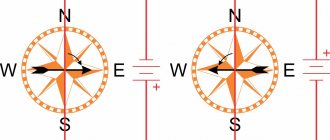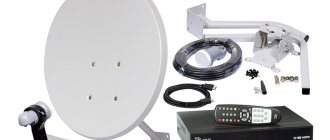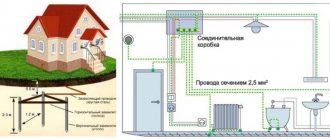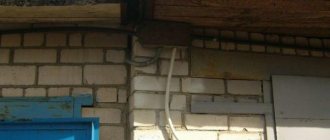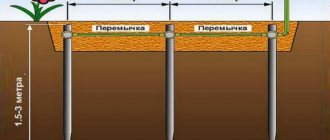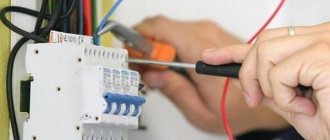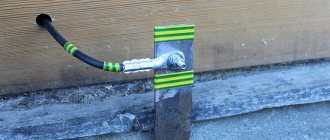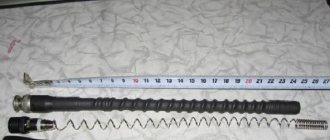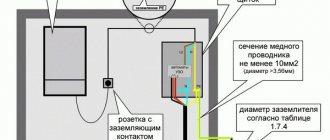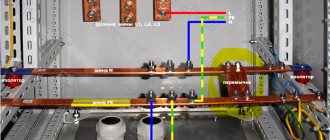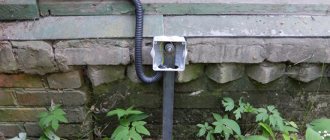During a thunderstorm, many of us do not unplug household appliances and home electronics. Such negligence is usually very costly. Every year during the summer, information appears about damage caused by lightning.
Electronics and, above all, television and computer equipment are the most sensitive to lightning discharges. Its electronic components are usually configured to operate at low voltages of the order of a few volts, so the appearance of an overvoltage of even a hundred volts will completely destroy them.
Lightning protection for antenna
Antennas installed on our roofs are potential sources of danger to devices inside the building. A direct lightning strike into an antenna mast can result in complete destruction of electronic equipment, including fire of the entire installation. A lightning strike near an antenna does not cause such a sharp effect, but it may well damage parts and circuits inside electrical and TV equipment.
Lightning is an electrical discharge in the atmosphere with a current of 10,000 to 500,000 amperes and a voltage of ten million to a billion volts. A lightning discharge creates an electromagnetic pulse that can destroy electronic equipment within a radius of several kilometers from the point of impact.
However, there is a way to effectively protect all connected playback devices by connecting them to highly sensitive overvoltage protection devices. The methods you will learn about in this article, in particular lightning protection for antennas, will help protect your antenna installation and television equipment. Not only from direct lightning strikes, but also from currents induced in wires and from the introduction of high potentials.
Is grounding always necessary?
Many of us believe that a lightning rod installed on the roof can protect home appliances from lightning. Not everything is right here. A lightning rod really protects a building from a thunderstorm, since it receives and discharges the main lightning strike - its high-voltage discharge - into the ground. But while this happens, an electromagnetic field has time to be generated in the lightning rod, and stray currents are formed that can cause overvoltage in the electrical system of the house and in its power supply line.
Consequences of lightning and electromagnetic pulse
An antenna installed on a building that is not equipped with lightning protection means there is a very high probability of lightning hitting the antenna and the risk of electric shock.
What risks arise during a thunderstorm? For the antenna system and television receivers interacting with it, threats can spread in the following scenarios:
- interaction of the electromagnetic field of a lightning discharge with the loops of wires that exist in the building;
- If the antenna mast is not grounded, then with a direct hit on the antenna, lightning current can penetrate inside the building. Flowing through various types of conductive installations, damage the devices in them;
- a direct lightning strike to the power lines supplying the building;
- a discharge in the immediate vicinity of an object can pose a threat due to the partial influx of lightning electricity through conductors buried in the ground.
You may be interested in: Digital TV set-top box
The home television system is very vulnerable to power surges during a thunderstorm. Therefore, grounding the antenna is one of the important measures in the complex of its protection, but not the only one.
Regulatory Requirements
Electrical safety requirements that apply to television systems and cable networks can be found in the “Rules for Electrical Installations” (7th ed.), as well as in the instructions RD 34.21.122-87. The measures listed in these basic regulations concern the protection of antenna systems, including satellite ones, from atmospheric phenomena and lightning strikes.
Regulatory Requirements
When carrying out installation work, qualified specialists are guided by the requirements established by the European Committee for Electrotechnical Standards. The main document regarding antenna grounding is called EN 50083-1.
This regulatory act describes the necessary actions to prevent the destructive consequences of lightning striking an antenna. The requirements regulate work related to the protection of only permanent lightning protection systems or devices installed in campsites. They do not apply to amateur radio stations operating on the VSAT platform.
Regulatory acts also include several other documents, including:
- GOST P IEC 62305-2-2010.
- GOST R IEC 62305-1-2010.
- Order of Rosstandart number 795.
Types of lightning protection
Grounding an antenna, whether in the private sector or in a city high-rise, is a way to “bury” part of the energy in the nearest lawn in the event of a direct lightning strike. The method is natural, but not one hundred percent. There are additional precautions that are successfully used in television networks - the use of special lightning protection devices. See for yourself: a TV that is connected to the mains has an antenna connector. Thus, even an unplugged device can be damaged if a lightning strike hits the antenna. The antenna wire must pass through surge protection elements before being introduced into the building. Coaxial protection modules have been designed specifically for the purpose of lightning protection for coaxial cable.
For coaxial cable lightning protection to be effective, all cables in your home TV network must be protected.
Antenna cable loop
The simplest of the homemade TV antennas is the loop one. To make it, you don’t need anything other than the cable itself (preferably with a copper core), a knife, pliers and an F-plug, which is needed to connect to the TV.
In short, it is done like this:
- Take a piece of coaxial cable (best with a copper center wire) about one and a half meters long.
- At one end, the insulation is removed from the central core and screen.
- After 22 cm the central vein is exposed.
- After another 22 cm, the insulation from the screen is removed.
- In the final cut, the central core and exposed braid are wrapped around the shielding sheath to form a ring.
- A plug is put on the other end of the cable.
Advantages:
Ease of manufacture. Knowing where to cut and what to close, you can make it in 5 minutes.
Flaws:
Suitable as a room one in conditions of a strong signal, but no more. It makes no sense to connect an amplifier to it, although some try (in particular, manufacturers of factory-made ring loop TV antennas built on the same principle).
The loop can be improved by using a spiral cable of a pre-calculated radius instead of a ring, improving the quality of the assembly (at the same time reducing losses), and calculating the matching. However, the only advantage of this type is that it is the most primitive. It’s easier to catch using a stripped coaxial cable or a piece of wire inserted into the central socket of the antenna plug on the TV.
Lightning protection device
Lightning rod from direct lightning strike
If your antenna rises alone above the roof and this is the highest point of your land, then you need to take a comprehensive approach to protecting your property and video equipment. First, you need to equip the roof of your house with a lightning rod and down conductor (ideally copper rod, 8 mm in diameter). To fix it on the roof, metal structures - holders - are mounted. The receiver is connected to the down conductor, and that to the grounding conductor. This may be a separate circuit, or there may be grounding switches located on your site if the wiring in the house was grounded.
Lightning protection for cable
The second stage of lightning protection is lightning protection for video circuits - a whole family of microdevices that operate on the principle of a fuse, which is installed in the form of a coaxial segment into a cable break. The purpose of any lightning protection is to neutralize the electromagnetic impact when lightning strikes an antenna installation. The design of lightning protection for television systems is such that when high voltage passes through it, its sensitive element - a fuse-link or a flask with gas - is destroyed, and the module leaves the telecommunication circuit, opening it. All cables require the correct selection of appropriate surge protection so as not to degrade the desired signal and, at the same time, provide effective protection.
Device made from aluminum cans
A fairly popular antenna model is made from simple aluminum drink cans. The containers have a lot of advantages, as they have a sufficient area when unfolded, have good conductivity close to copper, and have a streamlined shape that reduces windage. The main advantage is the absolute availability of the material.
In addition to the aluminum parts, you will need 10 m of high-quality television cable with a durable central core and a continuous double braid. You also need to prepare a wooden hanger, fasteners, electrical tape and a soldering tool. Then, following the instructions, you can begin assembly:
- First, the cable is prepared. It is cut at one end and partially cleared of the insulating coating.
- The inner copper core is then released.
- The opposite end is equipped with a nozzle for connecting to TV.
- The contacts, freed from insulation, are soldered to the banks.
- The cans are fixed in one line on the hanger using electrical tape at a distance of 7.5 cm.
Making your own television equipment is a great way to save money and an opportunity to acquire the necessary equipment. You can make your own Wi-Fi antenna, designs for analogue or digital television.
How to ground a TV antenna in the country
Country houses and the antennas that summer residents install on them are very vulnerable targets in a thunderstorm: there is hardly a high enough “bait” for lightning nearby (tall old trees, mobile operator towers, etc.). Especially if the dacha farm is located on lands that are just being developed.
You may be interested in: Inventions of the TV
If in bad weather a direct electric discharge hits the antenna, then even a lightning rod installed nearby will not protect either the TV or the tuner in the house. The discharge will definitely reach the nearest outlets. And here we are talking about saving the house, not the equipment. A lightning rod is, of course, good, but it will not protect against induced impulses and statics. That is why the country antenna must be reliably grounded; it must have its own ground loop.
Pin grounding
How to do this? Nowadays the pin type of grounding is very popular. In the finished factory kit, most likely you will find this type of ground electrode. It comes with its own instructions so that you do not make mistakes during installation.
- For those who are used to doing everything themselves: prepare a grounding loop: metal fittings with a diameter of 20 mm (steel, stainless steel, copper are suitable). Cable wire (PV-16.0 sq. mm), as an antenna connector with a recessed circuit.
- Drive the ground electrode to a depth of two meters, leaving the end of the metal rod 20 cm above the soil. You must connect the wire to it using a clamp or welding. Connect the other end of the current collector to the antenna.
How to install a ground loop
The ground loop should be an equilateral triangle. It must be located at least one meter from the house. The circuit can be divided into two segments:
- grounding conductors driven vertically into the soil (steel angles) connected to each other by horizontal grounding conductors (strip steel)
- grounding conductor (round steel) connecting the circuit to the electrical panel
You cannot use reinforcement - it will rust faster than the above materials.
First you need to mark the territory. Then dig a trench (about one meter deep). Horizontal grounding conductors will be laid here. After this, you need to drive in vertical grounding conductors (depth - two or three meters). The grounding conductors are driven in at the vertices of the triangle, but not entirely - about twenty centimeters should be above the ground. After the master has finished driving in the grounding rods, he must connect them with horizontal grounding rods using a welding inverter.
The next step after assembling the ground loop is connecting the loop to the electrical panel. Using a welding inverter, you need to weld the grounding conductor to the ground loop, and then lay a wire or steel strip to the electrical panel in the trench.
To prevent rust from appearing on the wires and to make them last longer, it is necessary to apply special anti-corrosion substances to them. You cannot paint the grounding with ordinary paints.
What not to do when grounding
As you know, the Russian people are cunning when it comes to invention. Often this trick turns against the owners themselves. The common myth that organizing residential grounding using jumpers in an outlet is a good example of this. Due to technical ignorance, and more often arrogance, residents resort to various tricks that have nothing to do with electrical safety. Regarding grounding your home TV network in case of a thunderstorm, know that no qualified electrician will advise you to do the following:
- attach the television antenna stand to the house ventilation duct or to the chimney;
- fix antenna cables near electrical cables or water pipes;
- use house engineering systems as grounding. Imagine what can happen when a powerful electric spark hits a gas pipeline!
Many have seen in films what happens when a hair dryer falls into a full bathtub. The same effect can be expected if lightning strikes a water supply or sewer network.
Recommendations for installing TA (television antenna)
Where the antenna will be placed on your site and how it should be oriented depends on a fairly large number of external factors. The main ones can be considered:
- the type of antenna you choose;
- site location;
- state of the area (relief);
- levels and types of external interference;
- interference caused by power parameters, type of AFU, etc.
If the antenna is mounted on the roof, then a small mast made of a metal pipe with a diameter of up to 40 mm, or a mast made of wooden beams (50*50) fixed to rafter beams, is used as a base. The antenna in these cases rises above the top point of the roof by 2000 mm or more.
FORBIDDEN:
- attach the antenna (its mast) to ventilation ducts and chimneys, to electrical “goosenecks” and telephone stands, as well as to dormer windows.
- fasten the antenna strings so that they pass close to its vibrators, or electrical wiring, to the pipes of the water supply system or window sills.
